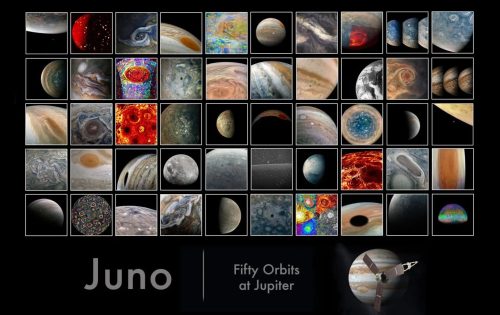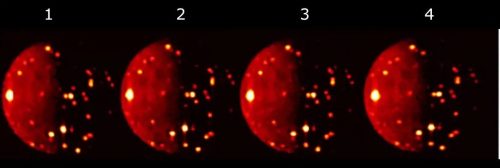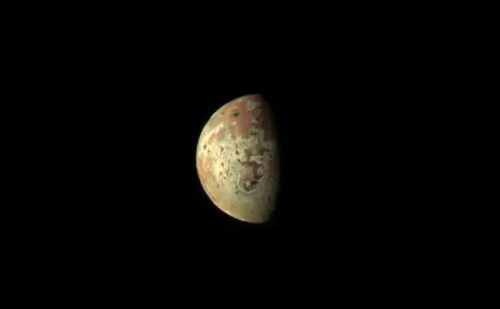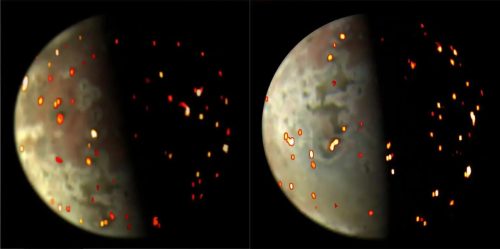
NASA’s Juno spacecraft continues to dazzle scientists and space enthusiasts alike as it embarks on its third year of an extended mission to explore the mysteries of Jupiter. The gas giant orbiter has flown over an impressive 510 million miles, capturing breathtaking images and crucial data during its 50 flybys of Jupiter.
One of its most remarkable achievements was documenting close encounters with three of Jupiter’s four largest moons – the icy worlds Europa and Ganymede, and the fiery moon Io. Recently, Juno accomplished its closest flyby to date with the volcanic moon Io, providing a stunning composite image that allows us to witness the turbulent and dynamic world of this celestial body.
Io – The Volcanic Wonder
Io, Jupiter’s innermost moon, has captured the fascination of astronomers and space enthusiasts for decades. Its volcanic activity is unparalleled in our solar system, making it the most volcanically active body we know of. Observing Io over time during multiple flybys is a significant breakthrough for scientists seeking to understand the moon’s volcanic processes.
Scott Bolton, Juno’s principal investigator from the Southwest Research Institute in San Antonio, notes that by closely observing the volcanoes, they can glean valuable insights such as eruption frequency, intensity, and even changes in lava flow patterns.

Juno’s Closest Encounter with Io
On May 16, Juno completed its closest flyby of Io, reaching an altitude of approximately 22,060 miles (35,500 kilometers) above the moon’s surface. This close approach allowed JunoCam, Juno’s onboard imaging system, to capture a series of data during four flybys. The images reveal breathtaking details of Io’s surface, providing scientists with a wealth of data to analyze and understand the moon’s dynamic geology.
Composite Image Unveils Io’s Secrets
The composite image generated from JunoCam’s data showcases Io’s diverse landscapes and the dynamic nature of its volcanic activity. As the spacecraft’s distance from the moon decreased during each flyby (perijove), the resolution of the images improved significantly. This progression in image quality offers a unique opportunity to study Io’s features in greater detail and track any changes that might occur over time.

Io’s Torment and Geological Processes
Measuring slightly larger than Earth’s moon, Io is a world in constant torment. Not only does it experience the relentless gravitational pull from Jupiter, the largest planet in our solar system, but it also faces the gravitational tugs from its sibling moons, Europa and Ganymede. This gravitational dance puts Io through continuous stretching and squeezing, which directly contributes to the creation of the spectacular lava seas erupting from its numerous volcanoes.
Juno’s Extended Mission
Juno’s extended mission aims to delve further into the mysteries of Jupiter and its moons. In the third year of its journey, the solar-powered spacecraft will focus on exploring Jupiter’s ring system, home to some of the gas giant’s inner moons. As Juno continues to orbit Jupiter, it will undertake additional flybys and capture invaluable data that will aid scientists in understanding the complex interactions and geophysical processes shaping Io and its neighboring moons.
The latest composite image of Io, captured by NASA’s Juno spacecraft during its closest flyby to date, unveils the stunning and violent beauty of Jupiter’s volcanic moon. The ongoing mission of Juno continues to provide us with a wealth of information about Jupiter and its moons, contributing to our understanding of the solar system’s complex dynamics.

As scientists study Io’s volcanic processes and ever-changing surface, the data collected by Juno will undoubtedly open new avenues of exploration and discovery for future space missions. With each flyby, Juno reveals more of Io’s secrets, drawing us closer to unlocking the mysteries of this fascinating celestial body and the intriguing gas giant, Jupiter.
